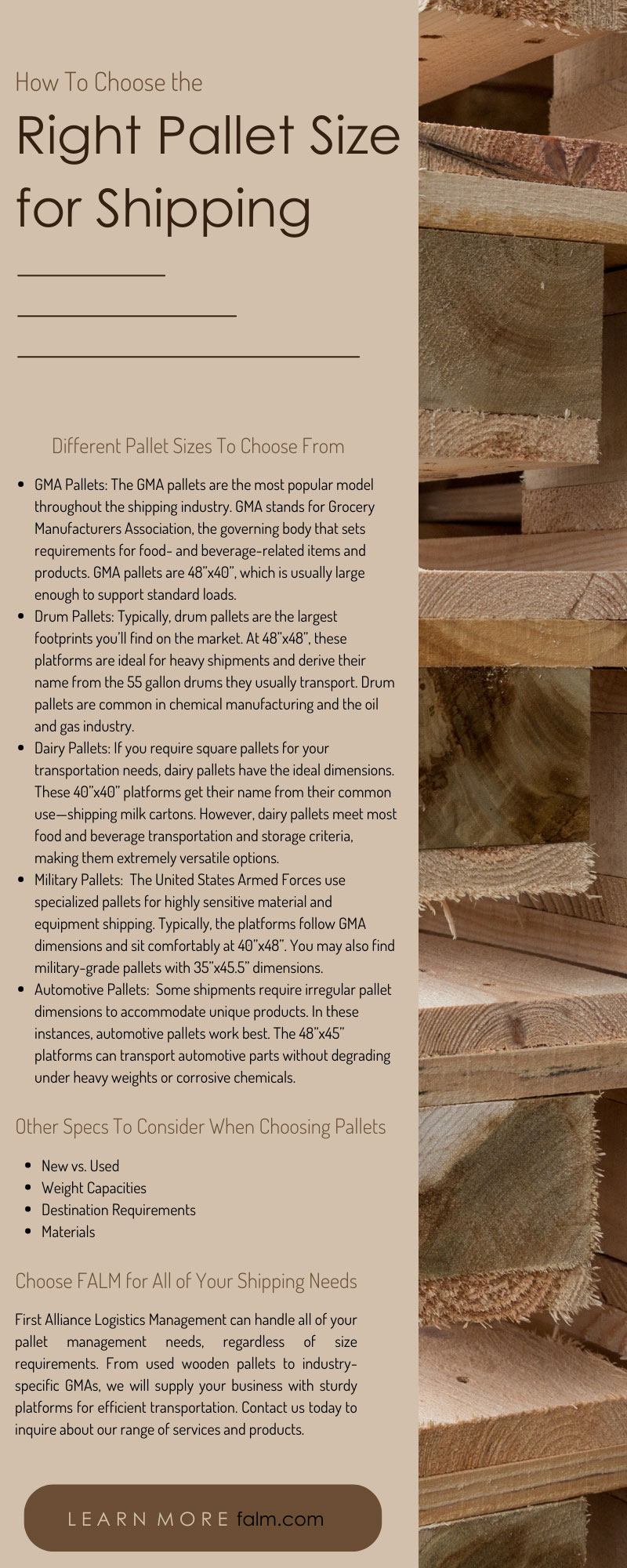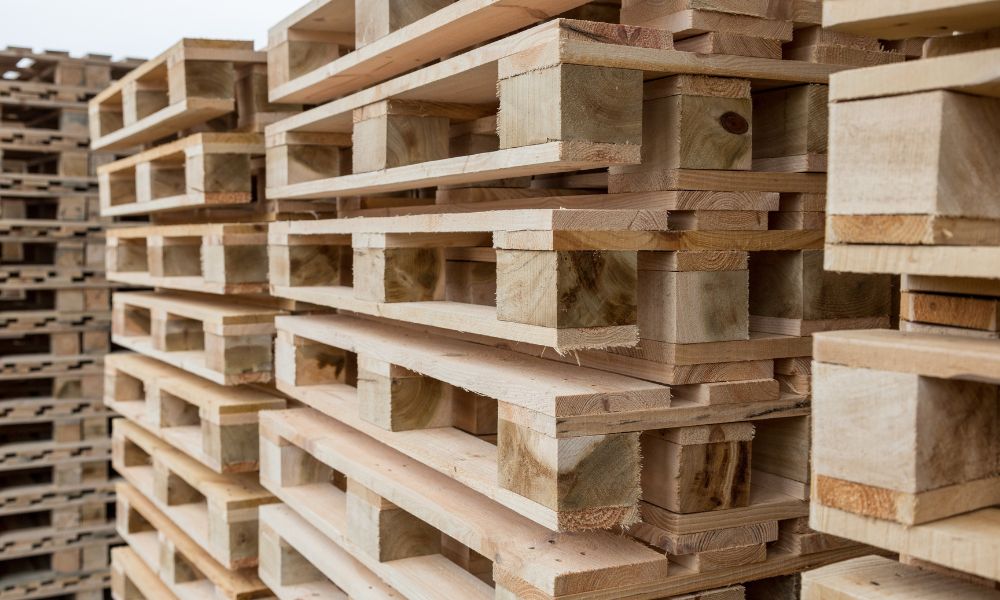Pallet shipping is a surprisingly rigid process. Certain pallets are more advantageous than others depending on the industry, product type, and destination. Therefore, selecting the right dimensions is crucial for efficient transportation.
How are you supposed to pick the best pallet size when there are so many options available? First Alliance Logistics Management is here to help you make the right decision. Choosing the right pallet size for shipping and the right pallet vendor is easy with this helpful guide.
Different Pallet Sizes To Choose From
First, you must understand the various pallet sizes. While logistics professionals refer to 48x40s as standard pallets, this title can be slightly misleading. The truth is that different industries have their own standards that also work for various other applications; what’s most common in one industry might still have use in another. To choose the right pallet size for shipping, here are your most common options.
GMA Pallets
The GMA pallets are the most popular model throughout the shipping industry. GMA stands for Grocery Manufacturers Association, the governing body that sets requirements for food- and beverage-related items and products. GMA pallets are 48”x40”, which is usually large enough to support standard loads.
The GMA pallets have a maximum weight capacity of over 2,800 lbs. They also have four-way access, making them ideal for warehousing environments. Platforms measuring 48”x40” are easy to access, meaning industries other than the grocery sector find them valuable.
Retail pallets are similar in popularity to GMAs but have altered dimensions. A 48”x20”, 20”x48”, and 20”x24” pallet is ideal for smaller shipments. Retail pallets help with space constraints and improve efficiency while transporting smaller loads.
Drum Pallets
Typically, drum pallets are the largest footprints you’ll find on the market. At 48”x48”, these platforms are ideal for heavy shipments and derive their name from the 55 gallon drums they usually transport. Drum pallets are common in chemical manufacturing and the oil and gas industry. They also work well to transport lab packing containers storing waste and by-products.
You could also find slightly smaller drum pallets, with dimensions sitting at 44”x44”. Both versions can feature double stringers for additional durability. If you need a large pallet that can support a lot of weight, drum pallets will do the job perfectly.
Dairy Pallets
If you require square pallets for your transportation needs, dairy pallets have the ideal dimensions. These 40”x40” platforms get their name from their common use—shipping milk cartons. However, dairy pallets meet most food and beverage transportation and storage criteria, making them extremely versatile options.
Military Pallets
The United States Armed Forces use specialized pallets for highly sensitive material and equipment shipping. Typically, the platforms follow GMA dimensions and sit comfortably at 40”x48”. You may also find military-grade pallets with 35”x45.5” dimensions.
Usually, the military ships parts and equipment by air. This means military pallets must be lightweight, durable, and easy to use. The industry standard is the 463L cargo pallet, which can withstand nearly 10,000 lbs. These pallets are unique because they feature aluminum casings to increase integrity.
Automotive Pallets
Some shipments require irregular pallet dimensions to accommodate unique products. In these instances, automotive pallets work best. The 48”x45” platforms can transport automotive parts without degrading under heavy weights or corrosive chemicals.
Automotive pallets aren’t exclusive to the automotive industry. They work well when shipping hazardous materials since they resist chemicals and other harsh substances. And because these platforms are usually plastic, they also work well for various food and beverage deliveries.
Custom Pallets
Of course, some businesses need to ship products and materials that don’t fit any of these standards. Logistics services like First Alliance Logistics Management can build custom wood pallets to meet any transportation need. Work with a pallet management service that offers repair, pickup, and buy-back services to keep your custom pallets in the supply chain.
Other Specs To Consider When Choosing Pallets
Choosing the right pallet size for shipping is only part of the job. You’ll need to consider other specifications, like materials, weight capacities, and destination requirements. Combining these factors with your preferred dimensions will help you select the best pallet for your unique transportation needs.
New vs. Used
First, you’ll need to decide if you want to ship your products with new or used pallets. New pallets have the advantage of being fresh, strong, and customizable. If you’re willing to pay the price, new pallets will always get the job done.
That’s not to say that used wooden pallets aren’t reliable. In fact, recycled pallets are just as strong as new pallets. Used pallets must undergo a grading process; those with B grades or higher are just as durable and usable as their newer counterparts. They’re also more cost-effective and help reduce your operation’s environmental impact.
Weight Capacities
The right pallet will be able to support your shipments without any strain. Make sure your chosen platforms have weight capacities that fit your loads. GMA, drum, and military pallets have enough strength to transport over 2,800 lbs of product each.
Military and drum pallets are especially helpful for heavy loads since manufacturers have fortified them with durable materials. From aluminum fixtures to additional center stringers, these platforms have higher weight capacities than you’ll likely need.
Destination Requirements
If you’re dealing with international shipping, you must understand destination requirements. For export purposes, most countries only permit the use of IPPC-ISPM heat-treated pallets.
Shipping within the US and Canada gives you more flexibility for size customizations. However, transporting materials to the UK and European Union requires the use of EURO pallets. These platforms range between 800mmx1200mm (31.50”x47.24”) and 1067mmx1067mm. (42”x42”).
Materials
Shipping pallets are made with various materials. The best one for your logistics needs will depend on your budget, industry, and workload. Used wooden pallets work well in more settings since they are heat-treatable and undergo a refurbishment process to increase strength.
Corrugated pallets are only good for one-way transport since they’re more fragile. And your other material option is metal, which is best for heavy-duty jobs that have a larger budget.
Choose FALM for All of Your Shipping Needs
First Alliance Logistics Management can handle all of your pallet management needs, regardless of size requirements. From used wooden pallets to industry-specific GMAs, we will supply your business with sturdy platforms for efficient transportation. Contact us today to inquire about our range of services and products.


